Recent debate regarding rail travel in Britain has revolved around the provision of first class facilities – with some saying they should be completely scrapped to reduce the problem of overcrowding. So with some uncertainty hanging over the future of first class train travel, Blue Guides’ resident rail expert Mark Dudgeon recently went roving on the rails to see what the fuss is all about – and is the extra cost of first class worth it?
Not all Train Operating Companies (TOCs) in Britain offer first class facilities. Generally, on shorter more commuter-oriented services, the trains are one-class-only. On many longer routes, however – principally the West Coast Main Line (London to the West Midlands, North-West England and Glasgow), the East Coast Main Line (London to Yorkshire, North-East England and Edinburgh) trains offer a separate first-class section with a reduced number of seats, more space and extra treats such as free catering.
Costs
First-class travel can be very expensive – especially buying “walk-up” tickets, and if travelling during peak periods, which are generally early-to-mid morning and late afternoon/early evening on Mondays to Fridays. A walk-up round-trip ticket for the 180-kilometre, 80-minute hop from Birmingham to London, for example, costs a painful £264 in first class.
These prices may be acceptable to the captive business market, but clearly many tourists would baulk at such extravagance. There are ways, however, of reducing the cost. Purchasing advance tickets (right up to the day before departure) for travel outside peak periods can reduce the costs significantly. Rail passes, such as a BritRail pass which is available to non-residents only, also can help, especially if you are travelling a lot by rail. If you are using a rail pass in Britain, there is the added advantage that reservations can be made free-of-charge at any staffed station – just remember to take your pass with you to make the reservations.
So what can you expect for the extra cost of travelling in first class? Generally, you’ll get a bigger and more comfortable seat – first class seating is usually three-across rather than four-across in standard class – and on several long-distance routes, free wi-fi is available. And then on many long-distance services, dependent on the time of day, there will be some form of complimentary catering offered.
Blue Guides put three of the major Train Operating Companies to the test ….
Virgin Trains
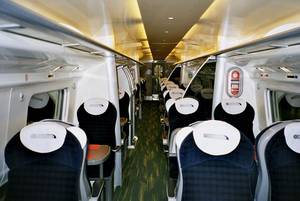
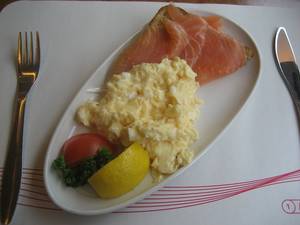
Virgin Trains operate the West Coast Main Line (WCML) franchise, with fast, frequent trains between London’s Euston station and: Birmingham and the West Midlands; Liverpool, Manchester and the north-west of England; and Carlisle and Glasgow. On the whole they are a well-regarded outfit, and there was an outcry when they were about to be stripped of the franchise a couple of years ago – a decision which was later reversed.
On Virgin’s flagship trains, the Pendolinos, first class can comprise up to four coaches, so be prepared for airline-style service. However, the quality of breakfasts, in particular, is consistently good and much better than you would receive on an average short-haul flight. Staff are efficient, occasionally tending to the brusque – probably because of the number of passengers they have to serve, often in quite a short space of time.
Full English breakfasts are generally served from a platter and consist of fried egg, tomato, sausage, bacon and a potato. Alternatives include vegetarian breakfast, scrambled eggs with salmon, and sausage muffin. Blue Guides found the English breakfast offering to be hot, freshly cooked and tasty, adequate in size, if not especially abundant. Toast and croissants are also served, with fruit juice and tea and coffee. Service could be touched up – grab the tea or coffee when you can – there may not be a second chance – and occasionally, as happened to the Blue Guides’ reporter once, you may find occasional slip-ups such as the fruit juices being served after the meal!
During the rest of the day, hot and cold snacks are served, and on some evening services from London a hot-course evening meal (often a curry or similar) is offered followed by dessert or cheese and biscuits. All accompanied by your choice of drinks (alcoholic or not) from the complimentary bar trolley. Full details of Virgin’s first class catering services are shown here on their website.
Seating is reasonably comfortable – seats are in twos or fours, generally facing each other with tables – but the inward sloping sides (necessary because of the tilting action of the train through curves) – do make the carriages feel, you might say, somewhat snug. There is the added bonus of free (and, in our experience, reliable) wi-fi in first class.
The service on Virgin’s other trains – the diesel-powered Voyagers, which mainly operate between London and North Wales, and Birmingham and Scotland – is reduced somewhat because of the lower demand (there is only one first class coach in each Voyager train set), although service tends to be more personalised.
At weekends and during holiday periods, complimentary catering is generally restricted to hot drinks and biscuits.
Blue Guides’ verdict: reasonably comfortable seating, if a little cramped; good breakfasts; free wi-fi generally works well. Worth it if you can get a good, off-peak advance fare, or are using a rail pass.
East Coast
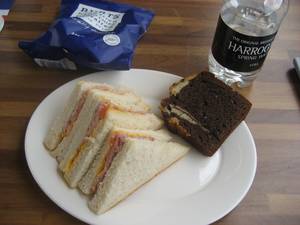
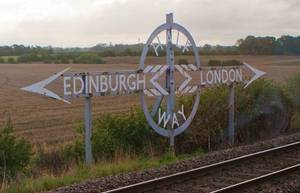
The East Coast Main Line, connecting the capital cities of England and Scotland is the Blue Riband route of the British rail network. Sights on the way include Durham cathedral, the striking Angel of the North sculpture before Newcastle, and later along the north-east coast of England the mystical Holy Island of Lindisfarne can be spotted in the distance, often shrouded in mist, followed by the border town of Berwick-upon-Tweed. On the way, look out for the large stencilled arrow signs appearing every so often by the side of the line: for example “Halfway between London and Edinburgh” and “Edinburgh 100 miles”. In order to get the best views, make sure you are sitting on the right side of the train (facing forward) going north, or, conversely, on the left side travelling south.
East Coast operates train services on this route, and – unusually – this is a nationalised body which took over the franchise when the previous operator forfeited it in 2009.
The seats in first class are comfortable – almost armchair-like – and there is more of a sense of space than on Virgin’s trains, even though East Coast’s trains are older. There is free Wi-Fi, but on the times Blue Guides has travelled on East Coast trains, the service has been very patchy and not reliable enough to do anything much more than occasionally checking or sending e-mails.
Complimentary catering in first class varies according to the time of day. There is a guide to what is available on the East Coast website, including a convenient, colour-coded timetable.
Blue Guides tested both the breakfast and daytime snack offerings. Breakfasts were ample and varied, although not consistently as good as on Virgin. The available options rotate on a weekly basis.
All-day snack offerings include a choice from a platter of fresh sandwiches, with pre-packaged biscuits, nibbles, and cakes. In the evening, a more substantial meal is offered on some services. As with Virgin Trains, the catering offering at weekends and during holiday periods is significantly reduced.
Service, we found, was inconsistent – some personnel were excellent and pro-active, while others were mediocre, sadly reminiscent of old, pre-privatisation British Rail days. The bar trolley offered soft and alcoholic drinks, but whether or not you were offered a refill seemed very much to be subject to the whim of the staff.
Blue Guides’ verdict: best part of the experience is the seating; the catering is reasonable and may or may not satisfy you depending on when and where you travel; forget the wi-fi.
Arriva Trains Wales
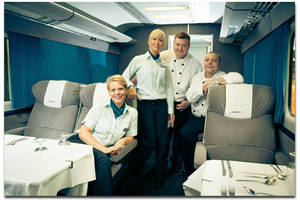
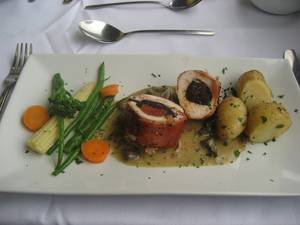
We’ve saved the best till last. You need to search hard to find the ne plus ultra of catering on British trains – and, it seems, not many people do. Indeed, on the day of the Blue Guides test, only three other passengers had the pleasure of this experience.
Arriva Trains Wales, which operates most of the trains within Wales (and between Wales and Birmingham and Manchester), doesn’t do first class on its high-density (some might say, spartan) trains – with one, glorious, exception. They don’t even call it first class – it’s called Premier Service, it’s an evening dining experience, and it’s only available on one train a day, five days a week. That train is the 17:16 departure from Cardiff to Holyhead, passing through Hereford, Shrewsbury and Chester before travelling along the North Wales coast to the Anglesey port. (On the early morning train in the reverse direction, breakfast is served).
Here you can experience the way trains used to be: a rake of coaches pulled by a locomotive, sitting in a proper, comfortable restaurant car with a menu and service to match. The menu generally consists of a choice of three appetisers, three main courses and three dessert and cheese options. On the day Blue Guides travelled on this train, the menu included: Baked local crab and cockle pots with fennel and Welsh cheddar; followed by: Pan-fried Gressingham duck breast served with braised red cabbage with apple, thyme and port, spring onion mash and peppercorn sauce; with Bara Brith, Cointreau butter pudding with cream to finish.
The three-course meal, soft and hot drinks are complimentary for passengers travelling with first class tickets and passes. The only thing that lets the experience down slightly is the wine list – reasonably priced, for sure, but on the day of our review, the only available wines were substitutes of poorer quality.
The service is personalised and friendly, and the atmosphere relaxed. This is a journey best experienced in the longer-day months of May or June, when the lovely, understated, scenery of the Welsh Marches can be savoured in all its finery, whilst sipping a glass of wine and enjoying the food in the way that civilised train travel should be. If you are travelling all the way on the longest days of year, you might well enjoy a fine sunset along the North Wales coast to boot. (We recommend you reserve seats in advance on this train: it is not compulsory, but there are only seventeen places).
So how and why does this train exist? Well, it’s operated by arrangement with the Welsh Assembly: it is financed, basically, by the Welsh taxpayer – to the tune of several thousand pounds per journey – in the interests of encouraging business connections between North and South Wales. So, be warned, it may not be around for long; and if you wish to experience it, make sure you reserve the right train because there are other, “normal” trains which ply this route.
Blue Guides’ verdict: great all-round experience, if you can get it! No extra charge for holders of a first class rail pass, but there is no wi-fi on this service.






